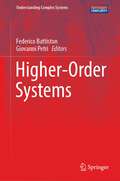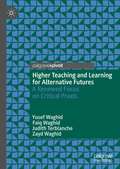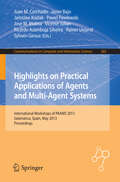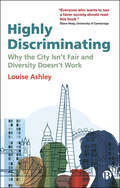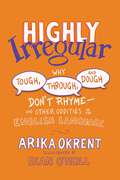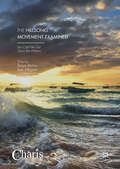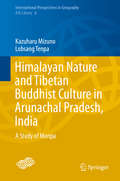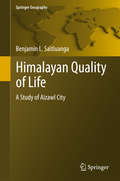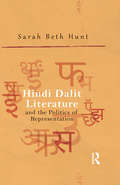- Table View
- List View
Higher-Order Systems (Understanding Complex Systems)
by Federico Battiston Giovanni PetriThe book discusses the potential of higher-order interactions to model real-world relational systems. Over the last decade, networks have emerged as the paradigmatic framework to model complex systems. Yet, as simple collections of nodes and links, they are intrinsically limited to pairwise interactions, limiting our ability to describe, understand, and predict complex phenomena which arise from higher-order interactions. Here we introduce the new modeling framework of higher-order systems, where hypergraphs and simplicial complexes are used to describe complex patterns of interactions among any number of agents. This book is intended both as a first introduction and an overview of the state of the art of this rapidly emerging field, serving as a reference for network scientists interested in better modeling the interconnected world we live in.
Higher Teaching and Learning for Alternative Futures: A Renewed Focus on Critical Praxis
by Yusef Waghid Faiq Waghid Judith Terblanche Zayd WaghidThis book analyses the narratives of four academics who consider themselves post-structuralist. Grounded in the work of major thinkers in post-structuralism, these narratives reflect on higher education as a community of scholars without community. The authors highlight what specifically motivates their pedagogical affirmations and orientations, analyse why they are concerned with social justice education, and what they envisage the alternative futures of higher education to be – that is, futures in which discrimination, oppression, violence and inequality are waning or have been eradicated. Through their own narratives, the authors tackle the educational matter of poststructuralist human encounters and expand upon the notion of social justice education. In doing so, they argue for higher education on the African continent as an alternative discourse that can be responsive to political, societal and environmental dystopias.
Highlights on Practical Applications of Agents and Multi-Agent Systems: International Workshops of PAAMS 2013, Salamanca, Spain, May 22-24, 2013. Proceedings (Communications in Computer and Information Science #365)
by Juan Manuel Corchado Rodríguez Javier Bajo Pérez Jaroslaw Kozlak Pawel Pawlewski Jose M. Molina Vicente Julián Ricardo Azambuja Silveira Rainer Unland Sylvain GirouxThis book constitutes the refereed proceedings of the Workshops which complemented the 11th International Conference on Practical Applications of Agents and Multi-Agent Systems, PAAMS 2013, held in Salamanca, Spain, in May 2013. This volume presents the papers that have been accepted for the workshops: Workshop on Agent-based Approaches for the Transportation Modeling and Optimization, Workshop on Agent-Based Solutions for Manufacturing and Supply Chain, Workshop on User-Centric Technologies and Applications, Workshop on Conflict Resolution in Decision Making, Workshop on Multi-Agent System Based Learning Environments, Workshop on Multi-agent based Applications for Sustainable Energy Systems, Workshop on Agents and multi-agent Systems for AAL and e-Health
Highly Discriminating: Why the City Isn’t Fair and Diversity Doesn’t Work
by Louise AshleyWhy does the City of London, despite an apparent commitment to recruitment and progression based on objective merit within its hiring practices, continue to reproduce the status quo? Written by a leading expert on diversity and elite professions, this book examines issues of equality in the City, what its practitioners say in public and what they think behind closed doors. Drawing on research, interviews, practitioner literature and internal reports, it argues that hiring practices in the City are highly discriminating in favour of a narrow pool of affluent applicants, and future progress may only be achieved by the state taking a greater role in organizational life. It calls for a policy shift at both the organizational and governmental level to address the implications of widening inequality in the UK.
Highly Discriminating: Why the City Isn’t Fair and Diversity Doesn’t Work
by Louise AshleyWhy does the City of London, despite an apparent commitment to recruitment and progression based on objective merit within its hiring practices, continue to reproduce the status quo? Written by a leading expert on diversity and elite professions, this book examines issues of equality in the City, what its practitioners say in public and what they think behind closed doors. Drawing on research, interviews, practitioner literature and internal reports, it argues that hiring practices in the City are highly discriminating in favour of a narrow pool of affluent applicants, and future progress may only be achieved by the state taking a greater role in organizational life. It calls for a policy shift at both the organizational and governmental level to address the implications of widening inequality in the UK.
Highly Irregular: Why Tough, Through, and Dough Don't RhymeAnd Other Oddities of the English Language
by Arika OkrentMaybe you've been speaking English all your life, or maybe you learned it later on. But whether you use it just well enough to get your daily business done, or you're an expert with a red pen who never omits a comma or misplaces a modifier, you must have noticed that there are some things about this language that are just weird. Perhaps you're reading a book and stop to puzzle over absurd spelling rules (Why are there so many ways to say '-gh'?), or you hear someone talking and get stuck on an expression (Why do we say "How dare you" but not "How try you"?), or your kid quizzes you on homework (Why is it "eleven and twelve" instead of "oneteen and twoteen"?). Suddenly you ask yourself, "Wait, why do we do it this way?" You think about it, try to explain it, and keep running into walls. It doesn't conform to logic. It doesn't work the way you'd expect it to. There doesn't seem to be any rule at all. There might not be a logical explanation, but there will be an explanation, and this book is here to help. In Highly Irregular, Arika Okrent answers these questions and many more. Along the way she tells the story of the many influences--from invading French armies to stubborn Flemish printers--that made our language the way it is today. Both an entertaining send-up of linguistic oddities and a deeply researched history of English, Highly Irregular is essential reading for anyone who has paused to wonder about our marvelous mess of a language.
Highly Irregular: Why Tough, Through, and Dough Don't RhymeAnd Other Oddities of the English Language
by Arika OkrentMaybe you've been speaking English all your life, or maybe you learned it later on. But whether you use it just well enough to get your daily business done, or you're an expert with a red pen who never omits a comma or misplaces a modifier, you must have noticed that there are some things about this language that are just weird. Perhaps you're reading a book and stop to puzzle over absurd spelling rules (Why are there so many ways to say '-gh'?), or you hear someone talking and get stuck on an expression (Why do we say "How dare you" but not "How try you"?), or your kid quizzes you on homework (Why is it "eleven and twelve" instead of "oneteen and twoteen"?). Suddenly you ask yourself, "Wait, why do we do it this way?" You think about it, try to explain it, and keep running into walls. It doesn't conform to logic. It doesn't work the way you'd expect it to. There doesn't seem to be any rule at all. There might not be a logical explanation, but there will be an explanation, and this book is here to help. In Highly Irregular, Arika Okrent answers these questions and many more. Along the way she tells the story of the many influences--from invading French armies to stubborn Flemish printers--that made our language the way it is today. Both an entertaining send-up of linguistic oddities and a deeply researched history of English, Highly Irregular is essential reading for anyone who has paused to wonder about our marvelous mess of a language.
Hightech am Ende: Über das globale Recycling von Elektroschrott und die Entstehung neuer Werte (Soziologie des Wertens und Bewertens)
by Stefan LaserStefan Laser folgt den Spuren des Werts von Elektroschrott. Mithilfe ethnographischer Studien bespricht er ein umkämpftes Gesetz in Indien, verfolgt als Mitarbeiter eines deutschen Recycling-Weltmarktführers das Schreddern und Schmelzen alter Elektronikgeräte und untersucht eine Google-Innovation zur Neugestaltung von Smartphones. Im Zentrum des Buchs steht die aufwendige, kontroverse Entstehung neuer Werte. Der Autor identifiziert das Hightech-Recycling als dominante politische und ökonomische Kraft im Umgang mit Elektroschrott – eine einseitige Strategie, die andere verdrängt und nicht zur nachhaltigen Vermeidung von Müll beiträgt.
Hilfe zwischen Generationen: Ein europäischer Vergleich
by Martina BrandtMartina Brandt betritt mit ihrem Buch neues Terrain. Im Gegensatz zu Studien, die ‘care’ allgemein fassen und darunter vor allem Pflegeleistungen subsumieren, - schäftigt sie sich ausdrücklich mit Hilfen unterhalb der Pflegeschwelle. Solche a- täglichen Leistungen wurden bislang noch kaum detailliert in den Blick genommen. Dabei stellen eher kurzfristige Hilfen im Haushalt, bei Gartenarbeiten, Reparaturen und bürokratischen Angelegenheiten bedeutende Unterstützungen dar. Sie erfolgen – ebenfalls im Gegensatz zu medizinisch anspruchsvoller Pflege – zwischen allen Familienmitgliedern zu allen Zeitpunkten und in alle Richtungen. Damit sind sie auch ein wichtiger Teil der Generationensolidarität unter Erwachsenen. Innovativ an der Studie ist auch, dass sie sich nicht allein auf ein einziges Land bezieht, sondern den internationalen Vergleich sucht. Dabei bietet sie sowohl wi- tige komparative Befunde als auch neue Erkenntnisse zu den einzelnen elf euro- ischen Ländern – von Schweden über Deutschland, Österreich und die Schweiz bis hin zu Griechenland. Ein Ziel des Buches ist es, das Modell intergenerationaler Solidarität auf Hilfen im europäischen Kontext zu übertragen. Dabei wird ins- sondere dem Einfluss kulturell-kontextueller Strukturen nachgegangen. Wie wirkt der Wohlfahrtsstaat auf den Generationenzusammenhalt in der Familie? Werden Familienleistungen verdrängt, gefördert, oder existiert vielmehr eine spezifische Kombination aus öffentlichen und privaten Unterstützungen? Es wird nicht nur die Hilfewahrscheinlichkeit, sondern auch deren (Zeit-) Intensität in Abhängigkeit von verschiedenen Faktorengruppen untersucht.
Hilfeleistungssysteme der Zukunft: Analysen des Deutschen Roten Kreuzes zur Aufrechterhaltung von Alltagssystemen für die Krisenbewältigung
by Matthias Max Matthias SchulzeKrisen und Katastrophen verändern sich stetig — sowohl in der Wahrnehmung als auch in der Bewältigung. Seit mehr als zehn Jahren analysiert das Deutsche Rote Kreuz mit seinem Kompetenzzentrum »Forschung und Innovationstransfer« bestehende Hilfeleistungssysteme. Matthias Max und Matthias Schulze präsentieren die Ergebnisse dieses Prozesses und zeigen, dass das DRK einen wichtigen Beitrag dazu leistet, Hilfeleistungssysteme der Zukunft zu gestalten.
Hilfeplangespräche in der Sozialpädagogischen Familienhilfe: Partizipation aus der Adressat*innenperspektive (Soziale Arbeit als Wohlfahrtsproduktion #28)
by Jana DemskiJana Demski untersucht in der vorliegenden Studie das Hilfeplangespräch aus der Adressat*innenperspektive. Elternschaft ist intensiviert und Familien können mit den (gesellschaftlichen) Ansprüchen überfordert sein. Sozialpädagogische Familienhilfe (SPFH) kann eine Antwort bereitstellen, doch fehlt es in diesem Handlungsfeld bislang an Forschungen. Die Hilfeplangespräche in der SPFH sollten im Sinne der Adressat*innen mehr Aufmerksamkeit erfahren, damit Adressat*innen in diesem zentralen Aushandlungsmomentum Partizipation erleben können.
Hillbilly Highway: The Transappalachian Migration and the Making of a White Working Class (Politics and Society in Modern America #157)
by Max FraserThe largely untold story of the great migration of white southerners to the industrial Midwest and its profound and enduring political and social consequencesOver the first two-thirds of the twentieth century, as many as eight million whites left the economically depressed southern countryside and migrated to the booming factory towns and cities of the industrial Midwest in search of work. The "hillbilly highway" was one of the largest internal relocations of poor and working people in American history, yet it has largely escaped close study by historians. In Hillbilly Highway, Max Fraser recovers the long-overlooked story of this massive demographic event and reveals how it has profoundly influenced American history and culture—from the modern industrial labor movement and the postwar urban crisis to the rise of today’s white working-class conservatives.The book draws on a diverse range of sources—from government reports, industry archives, and union records to novels, memoirs, oral histories, and country music—to narrate the distinctive class experience that unfolded across the Transappalachian migration during these critical decades. As the migration became a terrain of both social advancement and marginalization, it knit together white working-class communities across the Upper South and the Midwest—bringing into being a new cultural region that remains a contested battleground in American politics to the present.The compelling story of an important and neglected chapter in American history, Hillbilly Highway upends conventional wisdom about the enduring political and cultural consequences of the great migration of white southerners in the twentieth century.
Hillbilly Highway: The Transappalachian Migration and the Making of a White Working Class (Politics and Society in Modern America #157)
by Max FraserThe largely untold story of the great migration of white southerners to the industrial Midwest and its profound and enduring political and social consequencesOver the first two-thirds of the twentieth century, as many as eight million whites left the economically depressed southern countryside and migrated to the booming factory towns and cities of the industrial Midwest in search of work. The "hillbilly highway" was one of the largest internal relocations of poor and working people in American history, yet it has largely escaped close study by historians. In Hillbilly Highway, Max Fraser recovers the long-overlooked story of this massive demographic event and reveals how it has profoundly influenced American history and culture—from the modern industrial labor movement and the postwar urban crisis to the rise of today’s white working-class conservatives.The book draws on a diverse range of sources—from government reports, industry archives, and union records to novels, memoirs, oral histories, and country music—to narrate the distinctive class experience that unfolded across the Transappalachian migration during these critical decades. As the migration became a terrain of both social advancement and marginalization, it knit together white working-class communities across the Upper South and the Midwest—bringing into being a new cultural region that remains a contested battleground in American politics to the present.The compelling story of an important and neglected chapter in American history, Hillbilly Highway upends conventional wisdom about the enduring political and cultural consequences of the great migration of white southerners in the twentieth century.
Hillsong Church: Expansive Pentecostalism, Media, and the Global City (Palgrave Studies in Lived Religion and Societal Challenges)
by Miranda KlaverThis book highlights the expansion of the influential Pentecostal Hillsong Church global megachurch network from Australia across global cities. Ethnographic research in Amsterdam and New York City shows that global cities harbor nodes in transnational religious networks in which media play a crucial role. By taking a lived religion approach, media is regarded as integral part of everyday practices of interaction, expression and consumption of religion. Key question raised is how processes of mediatization shape, alter and challenge this thriving cosmopolitan expression of Pentecostalism. Current debates in the study of religion are addressed: religious belonging and community in global cities; the interrelation between media technology, religious practices and beliefs; religion, media and social engagement in global cities; media and emerging modes of religious leadership and authority. In this empirical study, pressing societal issues like institutional responses to sexual abuse of children, views on gender roles, misogyny and mediated constructions of femininity are discussed.
The Hillsong Movement Examined: You Call Me Out Upon the Waters
by Tanya Riches Tom WagnerThis interdisciplinary volume brings together leading writers and thinkers to provide a critique of a broad range of topics related to Hillsong Church. Hillsong is one of the most influential, visible, and (in some circles) controversial religious organizations/movements of the past thirty years. Although it has received significant attention from both the academy and the popular press, the vast majority of the scholarship lacks the scope and nuance necessary to understand the complexity of the movement, or its implications for the social, cultural, political, spiritual, and religious milieus it inhabits. This volume begins to redress this by filling important gaps in knowledge as well as introducing different audiences to new perspectives. In doing so, it enriches our understanding of one of the most influential Christian organizations of the late 20th and early 21st centuries.
The Hillsong Movement Examined: You Call Me Out Upon the Waters
by Tanya Riches Tom WagnerThis interdisciplinary volume brings together leading writers and thinkers to provide a critique of a broad range of topics related to Hillsong Church. Hillsong is one of the most influential, visible, and (in some circles) controversial religious organizations/movements of the past thirty years. Although it has received significant attention from both the academy and the popular press, the vast majority of the scholarship lacks the scope and nuance necessary to understand the complexity of the movement, or its implications for the social, cultural, political, spiritual, and religious milieus it inhabits. This volume begins to redress this by filling important gaps in knowledge as well as introducing different audiences to new perspectives. In doing so, it enriches our understanding of one of the most influential Christian organizations of the late 20th and early 21st centuries.
Himalaya: A Human History
by Ed DouglasThis is the first major history of the Himalaya: an epic story of peoples, cultures and adventures among the world’s highest mountains.Spanning millennia, from its earliest inhabitants to the present conflicts over Tibet and Everest, Himalaya is a soaring account of resilience and conquest, discovery and plunder, oppression and enlightenment at the ‘roof of the world’.From all around the globe, the unique and astonishing geography of the Himalaya has attracted those in search of spiritual and literal elevation: pilgrims, adventurers and mountaineers seeking to test themselves among the world’s most spectacular and challenging peaks. But far from being wild and barren, the Himalaya has throughout the ages been home to an astonishing diversity of indigenous and local cultures, as well as a crossroads for trade, and a meeting point and conflict zone for the world’s superpowers. Here Jesuit missionaries exchanged technologies with Tibetan Lamas, Mongol Khans employed Nepali craftsmen, Armenian merchants exchanged musk and gold with Mughals. Here too the East India Company grappled for dominance with China’s emperors, independent India has been locked in conflict with Mao’s Communists and their successors, and the ideological confrontation of the Cold War is now being buried beneath mass tourism and ecological transformation.Featuring scholars and tyrants, bandits and CIA agents, go-betweens and revolutionaries, Himalaya is a panoramic, character-driven history on the grandest but also the most human scale, by far the most comprehensive yet written, encompassing geology and genetics, botany and art, and bursting with stories of courage and resourcefulness.
Himalayan Nature and Tibetan Buddhist Culture in Arunachal Pradesh, India: A Study of Monpa (International Perspectives in Geography #6)
by Kazuharu Mizuno Lobsang TenpaThis is the first book to systematically describe the formation and historical changes of the Monpa people’s area (Monyul) through its nature, society, culture, religion, agriculture and historically deep ties with Bhutan, Tibet and the Tibetan Buddhist faith. The state of Arunachal Pradesh is located in the northeastern part of India, surrounded by the borders of Assam, Bhutan, and Tibet (China). There has been a long history of conflict over the sovereignty of this area between India and China. Foreigners were prohibited from entering the state until the 1990s and the area has been veiled in secrecy until recently. Thus, there are not many academically researched works on the region. This book serves as an essential guide for anyone who would like to learn about a unique geographical area of Monpa.
Himalayan Quality of Life: A Study of Aizawl City (Springer Geography)
by Benjamin L. SaitluangaThe book is a study of intra-urban inequality in quality of life (QOL) in Aizawl city. The main objectives of the study include analysis of processes and patterns of social differentiation along the three-dimensional space of Aizawl city as well as analysis of spatial inequality in QOL at the lowest administrative structure of the city. An investigation into spatial pattern of residential differentiation was done at both horizontal and vertical spaces. Spatial variation in well-being of residents of Aizawl city and the quality of their immediate environment was also studied by taking both objective and subjective indicators. The study employed a number of descriptive, inferential and multivariate statistical techniques including correlation, factor analysis, principal component analysis, cluster analysis and spatial autocorrelation methods like Moran’s I and Local Indicators of Spatial Association (LISA). Mapping techniques and graphical methods like Choropleth map, histogram and line graph were also used. With the help of factor analysis, the social space of Aizawl city was found to be differentiated along socio-economic status, family status, household size status, workers status and ethnic status. The most important factor determining residential differentiation was socio-economic status. Choropleth map of factor scores reveals that the inner city localities were dominated by high socio-economic class while poorer people dominated the peripheries. Non-local ethnic minorities were few but concentrated in some adjoining peripheral localities as well as in inner city localities which have been inhabited by their ancestors since the colonial period. Vertical pattern of residential differentiation was also analyzed by taking income variable as a proxy of socio-economic status. Multi-storey buildings in Aizawl city were co-inhabited by both richer people and poorer people. The richer people were found at the top floors while the poorer people occupied the basement floors. Normally, the owners of the buildings were found at the top floors while the basement floors were dominated by the renters. Spatial variation in QOL was measured with the help of principal component analysis as a weighting technique by taking variables pertaining to both objective and subjective QOL dimensions. The values of composite QOL index showed that the central localities have scored better than their peripheral counterparts. Correlation analysis of the relationship between objective indicators and subjective indicators provided a low positive value indicating the absence of relationship between the two dimensions of quality of life. Spatial autocorrelation analysis was also performed to see the pattern of clustering of spatially weighted QOL variables across Local Councils. With the help of Global Moran’s I, spatial clusters and spatial outliers were observed for objective dimension of QOL within the study area. The value of Moran’s I was found to be insignificant for subjective QOL dimension indicating the absence of significant pattern of clustering. The study also identified 7 social areas of Aizawl city on the basis of factor scores and composite scores of QOL variables calculated for all Local Councils. The identification of clusters was taken out with the help of hierarchical clustering method of cluster analysis. These clusters were labeled appropriate names and their characteristics were described in detail. The thesis concluded with recommendation of designating these social areas as ‘social development planning zones’ for obtaining inclusive development.
Hindi Christian Literature in Contemporary India (Routledge Studies in Religion)
by Rakesh Peter-DassThis is the first academic study of Christian literature in Hindi and its role in the politics of language and religion in contemporary India. In public portrayals, Hindi has been the language of Hindus and Urdu the language of Muslims, but Christians have been usually been associated with the English of the foreign ‘West’. However, this book shows how Christian writers in India have adopted Hindi in order to promote a form of Christianity that can be seen as Indian, desī, and rooted in the religio-linguistic world of the Hindi belt. Using three case studies, the book demonstrates how Hindi Christian writing strategically presents Christianity as linguistically Hindi, culturally Indian, and theologically informed by other faiths. These works are written to sway public perceptions by promoting particular forms of citizenship in the context of fostering the use of Hindi. Examining the content and context of Christian attention to Hindi, it is shown to have been deployed as a political and cultural tool by Christians in India. This book gives an important insight into the link between language and religion in India. As such, it will be of great interest to scholars of Religion in India, World Christianity, Religion and Politics and Interreligious Dialogue, as well as Religious Studies and South Asian Studies.
Hindi Christian Literature in Contemporary India (Routledge Studies in Religion)
by Rakesh Peter-DassThis is the first academic study of Christian literature in Hindi and its role in the politics of language and religion in contemporary India. In public portrayals, Hindi has been the language of Hindus and Urdu the language of Muslims, but Christians have been usually been associated with the English of the foreign ‘West’. However, this book shows how Christian writers in India have adopted Hindi in order to promote a form of Christianity that can be seen as Indian, desī, and rooted in the religio-linguistic world of the Hindi belt. Using three case studies, the book demonstrates how Hindi Christian writing strategically presents Christianity as linguistically Hindi, culturally Indian, and theologically informed by other faiths. These works are written to sway public perceptions by promoting particular forms of citizenship in the context of fostering the use of Hindi. Examining the content and context of Christian attention to Hindi, it is shown to have been deployed as a political and cultural tool by Christians in India. This book gives an important insight into the link between language and religion in India. As such, it will be of great interest to scholars of Religion in India, World Christianity, Religion and Politics and Interreligious Dialogue, as well as Religious Studies and South Asian Studies.
Hindi Cinema and Pakistan: Screening the Idea and the Reality
by Meenakshi BharatEver since the 1947 partition of the Indian subcontinent, Mumbai-based Hindi cinema has been returning compulsively to the idea of Pakistan, sometimes as the desirable other, sometimes as the horrifying antagonist. Hindi Cinema and Pakistan traces the genesis and development of this theme in Hindi cinema in the 1950s, showcasing its relevance as a tool that both reflects and shapes how India sees its neighbour, the India–Pakistan relationship, and itself.The book is a serious, multi-platform, multi-pronged exploration of the appearances, invocations, representations and treatment of Pakistan and Pakistanis in Hindi cinema. It follows Hindi cinema’s efforts to come to terms with the ‘idea’ and ‘reality’ of Pakistan. Through in-depth analyses of the enmity and rivalry between the two subcontinental nations in Partition films, thrillers, epic war films and sports films, to screen depictions of the shared cultural past and similarities in films on cross-border love or in films that show a reaching out through humour, this book investigates the visualization of Pakistan and contextualizes these representations within the broader frameworks of India’s political, socio-cultural and popular discourse.The extensive reach of the in-depth textual analyses of Hindi cinema will make this volume interesting and valuable both to the lay reader and to researchers and academics of cultural studies, media and film studies, and the study of socio-psychological violence in media and culture.
Hindi Cinema and Pakistan: Screening the Idea and the Reality
by Meenakshi BharatEver since the 1947 partition of the Indian subcontinent, Mumbai-based Hindi cinema has been returning compulsively to the idea of Pakistan, sometimes as the desirable other, sometimes as the horrifying antagonist. Hindi Cinema and Pakistan traces the genesis and development of this theme in Hindi cinema in the 1950s, showcasing its relevance as a tool that both reflects and shapes how India sees its neighbour, the India–Pakistan relationship, and itself.The book is a serious, multi-platform, multi-pronged exploration of the appearances, invocations, representations and treatment of Pakistan and Pakistanis in Hindi cinema. It follows Hindi cinema’s efforts to come to terms with the ‘idea’ and ‘reality’ of Pakistan. Through in-depth analyses of the enmity and rivalry between the two subcontinental nations in Partition films, thrillers, epic war films and sports films, to screen depictions of the shared cultural past and similarities in films on cross-border love or in films that show a reaching out through humour, this book investigates the visualization of Pakistan and contextualizes these representations within the broader frameworks of India’s political, socio-cultural and popular discourse.The extensive reach of the in-depth textual analyses of Hindi cinema will make this volume interesting and valuable both to the lay reader and to researchers and academics of cultural studies, media and film studies, and the study of socio-psychological violence in media and culture.
Hindi Dalit Literature and the Politics of Representation
by Sarah Beth HuntThis study explores how Dalits in north India have used literature as a means of protest against caste oppression. Including fresh ethnographic research and interviews, it traces the trajectory of modern Dalit writing in Hindi and its pivotal role in the creation, rise and reinforcement of a distinctive Dalit identity. The book challenges the existing impression of Hindi Dalit literature as stemming from the Dalit political assertion of the 1980s and as being chiefly imitative of the Marathi Dalit literature model. Arguing that Hindi Dalit literature has a much longer history in north India, it examines two differing strands that have taken root in Dalit expression — the early ‘popular’ production of smaller literary pamphlets and journals at the beginning of the 20th century and more contemporary modes such as autobiographies, short stories and literary criticism. The author highlights the ways in which such various forms of literary works have supported the proliferation of an all-encompassing identity for the so-called ‘untouchable’ castes. She also underscores how these have contributed to their evolving political consciousness and consolidation of newer heterogeneous identities, making a departure from their long-perceived image. The work will be important for those in Dalit studies, subaltern history, Hindi literature, postcolonial studies, political science and sociology as well as the informed general reader.
Hindi Dalit Literature and the Politics of Representation
by Sarah Beth HuntThis study explores how Dalits in north India have used literature as a means of protest against caste oppression. Including fresh ethnographic research and interviews, it traces the trajectory of modern Dalit writing in Hindi and its pivotal role in the creation, rise and reinforcement of a distinctive Dalit identity. The book challenges the existing impression of Hindi Dalit literature as stemming from the Dalit political assertion of the 1980s and as being chiefly imitative of the Marathi Dalit literature model. Arguing that Hindi Dalit literature has a much longer history in north India, it examines two differing strands that have taken root in Dalit expression — the early ‘popular’ production of smaller literary pamphlets and journals at the beginning of the 20th century and more contemporary modes such as autobiographies, short stories and literary criticism. The author highlights the ways in which such various forms of literary works have supported the proliferation of an all-encompassing identity for the so-called ‘untouchable’ castes. She also underscores how these have contributed to their evolving political consciousness and consolidation of newer heterogeneous identities, making a departure from their long-perceived image. The work will be important for those in Dalit studies, subaltern history, Hindi literature, postcolonial studies, political science and sociology as well as the informed general reader.
